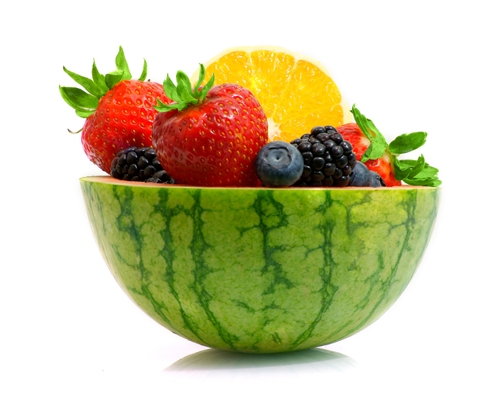Eating healthy during the summer isn’t easy

When executive chef James Boyer completed plans to give the menu at Canyon Ranch Grill at the Palazzo a summer face-lift, he sent the menu off to a group of 20 experts to pick each dish apart.
Boyer takes pride in the fact that Canyon Ranch patrons don’t have to think about eating healthfully.
But you don’t have that same luxury at home, and you probably don’t have a team of nutritionists to evaluate your summer diet.
Experts contacted by the Review-Journal warn that eating light in the summer doesn’t necessarily mean eating healthfully.
There are hidden dangers in summer fare – salads, smoothies and hot dogs and burgers made on the grill – that require some thought if you want to eat well as well as stay cool this summer.
Even if you think you’re eating light, it’s still important to pay attention to calories, says Joanna Gorman, a registered dietitian at University Medical Center.
“Keep track of your weight no matter what kind of meal plan you follow. If there was a diet that worked, we wouldn’t have a problem with obesity.”
HIT THE GRILL
It’s 110 degrees outside, and the last thing you want to do is fire up the oven.
Go out on the patio: Boyer can’t think of a better way to cook your food than on the grill. There’s no need to add butter or other cooking mediums, and fat in the meat cooks out and drips through the grate.
“You can’t go wrong,” he says.
But Gorman begs you: Throw out the wieners.
“It’s tough to get a hot dog that’s really healthy,” she says.
And rather than a “greasy hamburger,” opt for a turkey or veggie burger. If it’s chicken on the barbecue, Gorman suggests sticking with leaner breasts and legs rather than wings or thighs.
Mary Wilson, a registered dietitian and extension nutrition specialist at University of Nevada Cooperative Extension, recommends cutting off chicken skin and any visible meat fat before throwing it on the grill.
“It’s easier to do before cooking just because you can see it.”
It can be a challenge to get the recommended five servings of fruits and vegetables, so Gorman recommends throwing some veggies on the grill, too.
GO WITH WHAT’S FRESH
It’s like a recipe card in reverse. When Boyer is putting together a new dish, he looks at what’s in season first.
So what’s in season at Las Vegas Farmers Market? Well, just about everything. The peak season is starting, says Ginger Johnson, market co-founder, and will last through the fall.
From cucumbers, summer squash and heirloom tomatoes to strawberries, apricots and citrus fruits, now’s the time to get fresh produce grown in Nevada, California, Utah and Arizona. The two locations in town offer many varieties of fruits and vegetables you can’t find at the grocery store.
Johnson says the corn is starting to come in, the peaches are great and the melons – watermelon, cantaloupe, honeydew and others – are “totally amazing.”
The summer months are a great opportunity to eat plenty of fruits and vegetables, Wilson says. They’re full of potassium and water, the “most essential” element in a summer diet.
EASY ON THE DRESSING
Salads may be the ultimate low-maintenance food, but that doesn’t mean they’re inherently healthful. It’s a matter of what dressing and toppings (and how much of them) are used that make or break a nutritious salad.
“There’s nothing that grows that is harmful to the body,” Gorman says. “We get into problems when we start trying to dress it up.”
Ranch dressing can add a few hundred calories to a salad, as can a handful of candied nuts.
She suggests using vinaigrettes or other vinegar-based dressings, as vinegar is nearly calorie-free.
As for pasta or potato salads – skip the mayonnaise and use whole grains such as couscous or barley, she says.
For Boyer and Wilson, everything comes down to moderation.
“If you’re drowning it in dressing, now you’re doing something wrong,” Boyer says. “If you’re doing it lightly … to add a little contrasting flavor to the salad, you’re probably doing it right.”
SMOOTHIES AND BOOZE
There’s a Big Gulp waiting around just about every corner, and it’s a possible risk to summer health.
“Beverages are the biggest problem in the summer,” Gorman says.
The difference between traditional and sugar-free drinks can be more than 90 calories per 8 fluid ounces, and that adds up quickly.
Whether it’s a fruit smoothie or a soft drink, Gorman says it’s a matter of size.
Plus, not all smoothies are created equally, Boyer notes. If it’s homemade with simply fresh fruit and ice, he says, “you’re doing it the right way.” But a store-bought smoothie can be crammed with sugar, fats and all sorts of unnatural ingredients.
If you’re adding some dairy to beef up your smoothie, Gorman says light yogurts and other fat-free dairy products are the best choices.
When the alcohol comes out, Boyer again stresses moderation.
“A drink a day,” he says. “Our studies have shown that’s actually beneficial for you.”
If it’s hot, Boyer suggests you break out the blender and make that drink a frozen one.
But Gorman says there’s only one drink she recommends, if anything: wine. She says she doesn’t see any nutritional benefits in either beer or liquor.
Wilson says alcoholic or caffeinated drinks aren’t the best way to keep hydrated. A golfer herself, she understands the appeal of having a beer while playing 18 holes in the heat.
“Just make sure you drink water along with that beer,” she says.
Contact Kyle Potter at kpotter@reviewjournal.com or 702-383-0391.